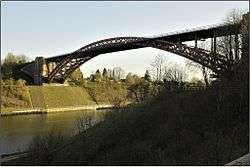Levensau High Bridge
| Levensau High Bridge Levensauer Hochbrücke | |
|---|---|
|
Levensau High Bridge | |
| Coordinates | 54°17′36.94″N 9°40′58.45″E / 54.2935944°N 9.6829028°ECoordinates: 54°17′36.94″N 9°40′58.45″E / 54.2935944°N 9.6829028°E |
| Carries | Kiel-Flensburg Railway, local road |
| Crosses | Kiel Canal |
| Characteristics | |
| Design | Arc bridge |
| Material | Steel |
| Total length | 180 metres (590 ft) |
| Longest span | 163 metres (535 ft) |
| Piers in water | None |
| Clearance above | 42 metres (138 ft) |
| History | |
| Construction begin | 1894 |
| Construction end | 1895 |
The Levensau High Bridge (German: Levensauer Straßen- und Eisenbahnhochbrücke ; short: Levensauer Hochbrücke) is a high level arch bridge that spans the Kiel Canal in the German state of Schleswig-Holstein. A second bridge nearby is referred to as Levensau Motorway Bridge (German: Levensauer Schnellstraßenbrücke).
Previous history
The lower section of the small river Levensau was extended between 1777 and 1784 to become part of the Eider Canal. Between 1887 and 1895 the Eider Canal was further extended and straightened to become part of the Kiel Canal (then Kaiser-Wilhelm-Kanal). The extended canal necessitated a fixed link for the Kiel–Flensburg railway as well as the principal road from Kiel to Eckernförde.[1]
Design and construction
Construction of the bridge took 1½ years. Work on the abutments was started in June 1893 and bricklaying lasted until end of that year. On top of the abutments the bridge featured four towers by architect Hermann Muthesius. The scaffolding that supported the steel elements during construction was erected from November 1893 and assembly of the steel construction started in May 1894. The bridge was inaugurated by Emperor Wilhelm II in December 1894.[1] Originally the carriageway was designed in a way that it could not be used by road and rail traffic simultaneously - if a train approached, the bridge was closed for cars and lorries. In the course of a first modification a bannister between road and railway was installed, however this limited the width of the road to 4.5 metres (15 ft) so that lorries were unable to pass each other on the bridge. Furthermore, the pedestrian way was only 90 centimetres (35 in) wide.[1] In the 1954 the bridge was extensively reworked to allow for independent use by road, rail and pedestrians. The towers were torn down and the carriageway was enlarged.[1]
Planned replacement
The current bridge's span is too narrow for the canal expansion to a width of 162 metres (531 ft). In 2009 the cost estimate for the replacement stood at 42 million Euros.
Bat habitat
About 5,000 common noctule and several other bat species hibernate inside the abutments. The population was examined by scientists of the Kiel University and is considered the largest in Northern Europe.
Gallery
Contemporary pictures
 The bridge from the west, 2005
The bridge from the west, 2005 Detail of the bridge, 2011
Detail of the bridge, 2011
Historic pictures
Being a landmark on the Kiel canal, the bridge was a popular background for pictures of ships transiting the canal.
 Armoured cruiser SMS Fürst Bismarck, 1900
Armoured cruiser SMS Fürst Bismarck, 1900 Light cruiser SMS Dresden, ca. 1912
Light cruiser SMS Dresden, ca. 1912 Battleship SMS Schleswig-Holstein, 1932
Battleship SMS Schleswig-Holstein, 1932 Components of the Alte Weser lighthouse, ca. 1961
Components of the Alte Weser lighthouse, ca. 1961
References
| Wikimedia Commons has media related to Levensau High Bridge. |
- 1 2 3 4 "Alte Levensauer Hochbrücke" [The old Levensau High Bridge]. www.wsa-kiel.wsv.de (in German). Federal Water and Shipping Administration. Retrieved 13 May 2012.
